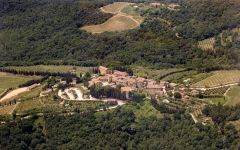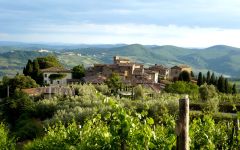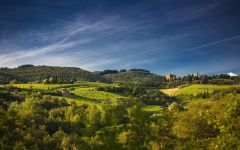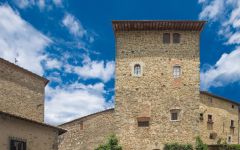Castello di Volpaia Chianti Classico 2016
-
James
Suckling -
Wine
Spectator - Decanter
-
Robert
Parker



Product Details
Your Rating
Somm Note
Winemaker Notes
Professional Ratings
-
James Suckling
Aromas of cherries, dried strawberries and red plums. Medium to full body, round and ripe tannins and a nice, fresh finish.
-
Wine Spectator
A hint of barnyard in the aroma gives way to bright cherry and strawberry fruit and vanilla and underbrush accents. Supple initially, firming up on the lingering finish. This should come around in a few years. Best from 2021 through 2029.
-
Decanter
Purchased as a hunting retreat by Raffaello Stianti in 1966, Castello di Volpaia encompasses an 11th century fortified village in Radda-in-Chianti. Today the estate includes 43ha of vineyards reaching up to 600 metres. For this wine, Merlot is included to make it more approachable, but it still has the potential to age. Red berries and earth notes reveal themselves slowly, with perfumed violet nuances showing up on the palate. Firm but refined tannins hold it all together, and the finish lingers with appetising minerality.
-
Robert Parker's Wine Advocate
Showing ripe fruit and rich intensity, the 2016 Chianti Classico (made with 90% Sangiovese and 10% Merlot) would pair nicely next to pasta with extra cheese grated on top. This wine is bright and fruit-forward with the fresh acidity to cut though the fat in cheese, butter or cream. The tight and focused nature of the wine's sharp berry flavors would also make a perfect contrast to the natural sweetness in those ingredients. This is always a great food wine, but this vintage is even better poised to match your favorite Italian dishes.
Rating: 90+
Other Vintages
2021-
Wine
Spectator -
Jeb
Dunnuck
-
James
Suckling -
Jeb
Dunnuck -
Wine
Spectator -
Robert
Parker
-
Wine
Enthusiast
-
James
Suckling -
Wine &
Spirits -
Wine
Enthusiast -
Robert
Parker
-
James
Suckling -
Wine
Enthusiast -
Wine
Spectator - Decanter
-
Wine
Enthusiast -
Wine
Spectator
-
James
Suckling
-
James
Suckling -
Wine
Enthusiast
-
Wine
Enthusiast -
Wine
Spectator
-
Robert
Parker
-
Robert
Parker -
Wine
Enthusiast
-
Wine &
Spirits
-
Wine
Enthusiast
-
Wine
Spectator
-
Wine
Spectator

Among Italy's elite red grape varieties, Sangiovese has the perfect intersection of bright red fruit and savory earthiness and is responsible for the best red wines of Tuscany. While it is best known as the chief component of Chianti, it is also the main grape in Vino Nobile di Montepulciano and reaches the height of its power and intensity in the complex, long-lived Brunello di Montalcino. Somm Secret—Sangiovese doubles under the alias, Nielluccio, on the French island of Corsica where it produces distinctly floral and refreshing reds and rosés.

One of the first wine regions anywhere to be officially recognized and delimited, Chianti Classico is today what was originally defined simply as Chianti. Already identified by the early 18th century as a superior zone, the official name of Chianti was proclaimed upon the area surrounding the townships of Castellina, Radda and Gaiole, just north of Siena, by Cosimo III, Grand Duke of Tuscany in an official decree in 1716.
However, by the 1930s the Italian government had appended this historic zone with additonal land in order to capitalize on the Chianti name. It wasn’t until 1996 that Chianti Classico became autonomous once again when the government granted a separate DOCG (Denominazione di Origine Controllata e Garantita) to its borders. Ever since, Chianti Classico considers itself no longer a subzone of Chianti.
Many Classicos are today made of 100% Sangiovese but can include up to 20% of other approved varieties grown within the Classico borders. The best Classicos will have a bright acidity, supple tannins and be full-bodied with plenty of ripe fruit (plums, black cherry, blackberry). Also common among the best Classicos are expressive notes of cedar, dried herbs, fennel, balsamic or tobacco.










